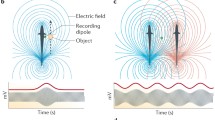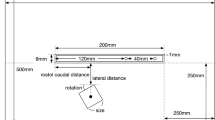Abstract
This review addresses the biophysical mechanisms of image formation in electrosensory systems. These electrical images are used for navigation and object detection by many species of fish, some amphibians, and some mammals. In the active electrosensory systems of fish these images are formed by the fish’s own electric organ discharge. In the passive electrosensory systems of fish, amphibians and mammals the images are formed by external electrical sources. In this review we describe the biophysics of image formation, the effects of the organism’s passive electrical properties, the role of exploration, and the influence of context on electroreception. We suggest that the basic principles established in these specialized systems be useful for understanding other more common sensory systems.
Similar content being viewed by others
References
Aguilera, P.A., Caputi, A.A. 2003. Electroreception in G. carapo: Detection of changes in waveform of the electrosensory signals. Journal of Experimental Biology 206, 989–998.
Bacelo, J. 2007. Sensory processing in the Electrosensory lobe of the weakly electric fish. Gnathonemus petersii These de Doctorat de l’Universite Paris 6 Pierre et Marie Curie.
Bacelo, J., Engelmann, J., Hollmann, M., von der Emde, G., Grant, K. 2008. Functional foveae in an electrosensory system. The Journal of Comparative Neurology 511, 342–359.
Baillet-Derbin, C. 1988. Motoneuron organization in the spinal cord of three teleost fishes, Gymnotus carapo (Gymnotidae), Gnathonemus petersii (Mormyridae) and Salmo trutta (Salmonidae). Biol Struct and Morphogenesis 1, 160–170.
Bastian, J. 1977. Variations in the frequency response of electroreceptors dependent on receptors location in weakly electric fish (Gymnotidei) with a pulse discharge. Journal of Comparative Physiology A 121, 53–64.
Bastian, J. 1995. Pyramidal-cell plasticity in weakly electric fish: A mechanism for attenuating responses to reafferent electrosensory inputs. Journal of Comparative Physiology A 176, 63–78.
Bastian, J., Chacron, M., Maler, L. 2004. Plastic and non-plastic pyramidal cells perform unique roles in a network capable of adaptative redundancy reduction. Neuron 41, 767–779.
Bell, C.C., Caputi, A.A., Grant, K., Serrier, J. 1993. Storage of a sensory image in the electric lobe of Gnathonemus petersii. Proceedings of the National Academy of Sciences of the United States of America, 90, 4650–4654.
Bell, C.C., Caputi, A., Grant, K. 1997. Physiology and plasticity of morphologically identified cells in the Mormyrid electrosensory lobe. Journal of Neuroscience 17, 6409–6423.
Bennett, M.V.L. 1970. Comparative physiology: electric organs. Annual Review of Physiology 32, 471–528.
Bodznick, D., Montgomery, J.C. 1994. The physiology of low-frequency electrosensory systems. In: Bullock, T.H., Hopkins, C.D., Popper, A.N., Fay, R.R. (Eds.), Electroreception, Springer, New York, 132–153.
Brown, M.C., Santos-Sacchi, J. 2008. Audition. In: Squire, L., Berg, D., Bloom, F., du Lac, S., Ghosh, A., and Spitzer, N. (Eds.), Fundamental Neuroscience. Academic Press, Canada, 609–636.
Budelli, R., Caputi, A.A. 2000. The electric image in weakly electric fish: Perception of objects of complex impedance. Journal of Experimental Biology 203, 481–492.
Budelli, R., Caputi, A.A., Gómez, L., Rother, D., Grant, K. 2002. The electric image in Gnathonemus petersii. Journal of Physiology (Paris) 96, 421–442.
Caputi, A.A. 1999. The EOD of pulse gymnotiforms: The transformation of a simple impulse into a complex spatio-temporal electromotor pattern. Journal of Experimental Biology 202, 1229–1241.
Caputi, A.A. 2004. Contributions of electric fish to the understanding of reafferent sensory systems. Journal of Physiology (Paris) 98, 81–97.
Caputi, A., Budelli, R. 1995. The electric image in weakly electric fish: I. A data-based model of waveform generation in Gymnotus carapo. Journal of Computational Neuroscience 2, 131–147.
Caputi, A.A., Budelli, R. 2006. Peripheral electric imaging in freshwater electric fish. Journal of Comparative Physiology 192, 587–600.
Caputi, A., Macadar, O., Trujillo-Cenóz, O. 1989. Waveform generation in Gymnotus carapo. III. Analysis of the fish body as an electric source. Journal of Comparative Physiology A 165, 361–370.
Caputi, A.A., Budelli, R., Grant, C., Bell, C.C. 1998. The electric image in weakly electric fish. Physical images of resistive objects in Gnathonemus petersii. Journal of Experimental Biology 201, 2115–2128.
Caputi, A.A., Castelló, M.E., Aguilera, P., Trujillo-Cenoz, O. 2002. Peripheral aspects of electrolocation and electrocommunication in Gymnotus carapo. Journal of Physiology (Paris) 96, 493–505.
Caputi, A.A., Aguilera, P.A., Castelló, M.E. 2003. Probability and amplitude of the novelty response as a function of the change in contrast of the reafferent in Gymnotus carapo. Journal of Experimental Biology 206, 999–1010.
Caputi, A.A., Castelló, M.E., Aguilera, P.A., Pereira, A.C., Nogueira, J., Rodríguez-Cattaneo, A., Lezcano, C. 2008. Active electroreception in Gymnotus omari: Imaging, object discrimination, and early processing of actively generated signals. Journal of Physiology (Paris) 102, 256–271.
Carlson, B.A, Hopkins, C.D. 2004. Stereotyped temporal patterns in electrical communication. Animal Behaviour 68, 867–878.
Castelló, M., Caputi, A., Trujillo-Cenóz, O. 1998. Structural and functional aspects of the fast electrosensory pathway in the electrosensory lateral line lobe of the pulse fish Gymnotus carapo. Journal of Comparative Neurology 401, 549–563.
Castelló, M.E., Aguilera, P.A., Trujillo-Cenóz, O., Caputi, A.A. 2000. Electroreception in Gymnotus carapo: Pre-receptor processing and the distribution of electroreceptor types. Journal of Experimental Biology 203, 3279–3287.
Chittka, L., Brockmann, A. 2005. Perception space — The final frontier. PloS Biology 3, e137.
Engelmann, J., Nöbel, S., Röver, T., von der Emde, G. 2009. The Schnauzenorgan-response of Gnathonemus petersii. Frontiers in Zoology 6, 21.
Feng, A.S. 1977. The role of the electrosensory system in postural control of the weakly electric fish Eigenmannia virescens. Journal of Neurobiology 8, 429–437.
Fessard, A., Szabo, T. 1961. Mise en evidence d’un récepteur sensible à l’électricité dans la peau d’un mormyre. Comptes Rendus Hebdomadaires des Seances de l’Academie des Sciences, Paris 253, 1859–1860.
Fulton, J.F. (Ed.) 1946. Howell’s Textbook of Physiology, 15 ed. W. B. Saunders Company, Philadelphia, 305–333.
Gibson, J.J. 1966. The Senses Considered as Perceptual Systems. Houghton Mifflin, Boston.
Graff, C., Kaminski, G., Gresty, M., Ohlmann, T. 2004. Fish perform spatial pattern recognition and abstraction by exclusive use of active electrolocation. Current Biology 14, 818–823.
Heiligenberg, W. 1974. Electrolocation and jamming avoidance in a Hypopygus (Rhamphichthyidae, Gymnotoidei), an electric fish with pulse-type discharges. Journal of Comparative Physiology 91, 223–240.
Hopkins, C.D. 2005. Passive electrolocation and the sensory guidance of oriented behavior. In: Bullock, T.H., Hopkins, C.D., Popper, A.N. and Fay, R.R. (Eds.), Electroreception. Springer, New York, 264–289.
Kalmijn, A.J. 1974. The detection of electric fields from inanimate and animate sources other than electric organs. In: Fessard, A. (Ed.), Handbook of Sensory Physiology, vol. III/3: Electroreceptors and Other Specialized Receptors in Lower Vertebrates. Springer-Verlag, Berlin, 147–200.
Lissmann, H.W. 1958. On the function and evolution of electric organs in fish. Journal of Experimental Biology 35, 156–191.
Lissmann, H.W., Machin, K.E. 1958. The mechanism of object location in Gymnarchus niloticus and similar fish. Journal of Experimental Biology 35, 451–486.
Machin, K.E., Lissmann, H.W. 1960. The mode of operation of the electric receptors in Gymnarchus niloticus. Journal of Experimental Biology 37, 801–811.
Mc Gregor, P.K., Westby, G.W.M. 1992. Discrimination of individually characteristic electric organ discharges by a weakly electric fish. Animal Behaviors 43, 977–986.
Meyer, J.H. 1982. Behavioral responses of weakly electric fish to complex impedances. Journal of Comparative Physiology A 145, 459–470.
Meyer, D.L., Heiligenberg, W., Bullock, T.H. 1976. The ventral substrate response. A new postural control mechanism in fishes. Journal of Comparative Physiology A 109, 59–68.
Migliaro, A., Caputi, A., Budelli, R. 2005. Theoretical analysis of pre-receptor image conditioning in weakly electric fish. PLoS Computational Biology 1, e16.
Mohr, C., Roberts, P.D., Bell, C.C. 2003. The mormyromast region of the mormyrid electrosensory lobe. I. Responses to corollary discharge and electrosensory stimuli. Journal of Neurophysiology 90, 1193–1210.
Nelson, M.E. 2005. Target detection, image analysis and modeling. In: Bullock, T.H., Hopkins, C.D., Popper, A.N. and Fay, R.R. (Eds.), Electroreception. Springer, New York, 297–310.
Nelson, M.E., MacIver, M.A. 1999. Prey capture in the weakly electric fish Apteronotus albifrons: Sensory acquisition strategies and electrosensory consequences. Journal of Experimental Biology 202, 1195–1203.
Nunez, P. 1981. Electric fields of the brain. In: The Neurophysics of EEG. Oxford University Press, New York.
Pereira, A.C. 2009. Alcance espacial y efectos de contexto en el sentido eléctrico activo de Gymnotus omari. Master thesis, UDELAR, Montevideo.
Pereira, A.C., Centurion, V., Caputi, A.A. 2005. Contextual effects of small environments on the electric images of objects and their brain evoked responses in weakly electric fish. Journal of Experimental Biology 208, 961–972.
Post, N., von der Emde, G. 1999. The ‘novelty response’ in an electric fish: Response properties and habituation. Physiology & Behavior 68, 115–128.
Pusch, R., von der Emde, G., Hollmann, M., Bacelo, J., Nobel, S., Grant, K., Engelmann, J. 2008. Active sensing in a mormyrid fish: Electric images and peripheral modifications of the signal carrier give evidence of dual foveation. Journal of Experimental Biology 211, 921–934.
Rasnow, B. 1996. The effects of simple objects on the electric field of Apteronotus. Journal of Comparative Physiology A 178, 397–411.
Reid, R.C., Usrey, W.M. 2008. Vision. In: Squire, L., Berg, D., Bloom, F., du Lac, S., Ghosh, A. and Spitzer, N. (Eds.), Fundamental Neuroscience. Academic Press, Canada, 637–659.
Rodríguez-Cattáneo, A., Pereira, A.C., Aguilera, P.A., Crampton, W., Caputi, A.A. 2008. Species-specific diversity of a fixed motor pattern: The electric organ discharge of Gymnotus. PLoS ONE 3(5), e2038.
Rother, D., Migliaro, A., Canetti, R, Gomez, L., Caputi, A., Budelli, R. 2003. Electric images of two low resistance objects in weakly electric fish. Biosystems 71, 169–177.
Scheich, H., Bullock, T.H. 1974. The detection of electric fields from electric organs. In: Fessard, A. (Ed.), Handbook of Sensory Physiology. Springer-Verlag, Berlin, 201–257.
Schwarz, S., von der Emde, G. 2001. Distance discrimination during active electrolocation in the weakly electric fish Gnathonemus petersii. Journal of Comparative Physiology A 186, 1185–1197.
Sears, F. W., Zemanski, M.W. 1954. Física General. Aguilar, Madrid.
Sicardi, A., Caputi, A., Budelli, R. 2000. Physical basis of electroreception. Physica A 286, 86–93.
Silva, A., Quintana, L., Perrone, R., Sierra, F. 2008. Sexual and seasonal plasticity in the emission of social electric signals. Behavioral approach and neural bases. Journal of Physiology (Paris) 102, 272–278.
Sperry, R.W. 1950. Neural basis of the spontaneous optokinetic response produced by visual inversion. Journal of Comparative Physiology and Psychology 43, 482–489.
Trujillo-Cenóz, O., Bertolotto, C. 1988. Some aspects of the structural organization of the spinal-cord of Gymnotus carapo (Teleostei, Gymnotiformes). II. The motoneurons. Journal of ultrastructure and molecular structure research 101, 224–235.
Trujillo-Cenóz, O., Echague, J.A. 1989. Waveform generation of the electric organ discharge in Gymnotus carapo. I. Morphology and innervation of the electric organ. Journal of Comparative Physiology A 165, 343–351.
von der Emde, G. 1990. Discrimination of objects through electrolocation in the weakly electric fish Gnathonemus petersii. Journal of Comparative Physiology A 167, 413–421.
von der Emde, G., Bell, C.C. 1994. Responses of cells in the mormyrid electrosensory lobe to EODs with distorted waveforms: Implication for capacitance detection. Journal of Comparative Physiology A 175, 83–93.
von der Emde, G., Schwarz, S., Gomez, L., Budelli, R., Grant, K. 1998. Electric fish measure distance in the dark. Nature 395, 890–894.
von der Emde, G., Amey, M., Engelmann, J., Fetz, S., Folde, C., Hollmann, M., Metzen, M., Pusch, R. 2008. Active electrolocation in Gnathonemus petersii: Behavior, sensory performance and receptor systems. Journal of Physiology (Paris) 102, 279–290.
von Holst, E., Mittelstaed, H. 1950. The reafferece principle. Naturwissenchaften 37, 464–476.
Watson, D., Bastian, J. 1979. Frequency response characteristics of the electroreceptors in the weakly electric fish, Gymnotus carapo. Journal of Comparative Physiology 134, 191–202.
Zellick, R., von der Emde, G. 1995. Behavioral detection of electric signal waveform distortion in the weakly electric fish Gnathonemus petersii. Journal of Comparative Physiology A 177, 493–501.
Author information
Authors and Affiliations
Corresponding author
Rights and permissions
About this article
Cite this article
Pereira, A.C., Caputi, A.A. Imaging in electrosensory systems. Interdiscip Sci Comput Life Sci 2, 291–307 (2010). https://doi.org/10.1007/s12539-010-0049-2
Received:
Revised:
Accepted:
Published:
Issue Date:
DOI: https://doi.org/10.1007/s12539-010-0049-2




